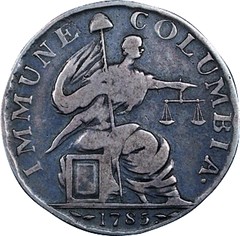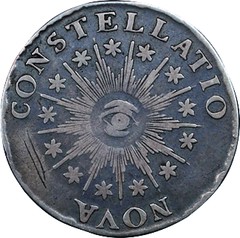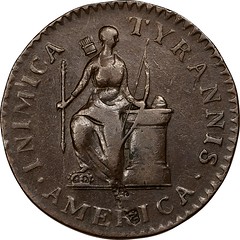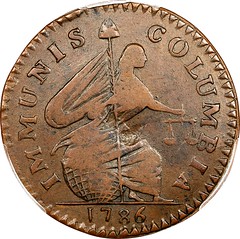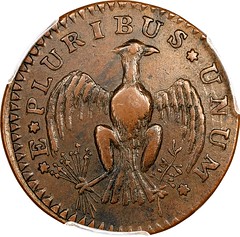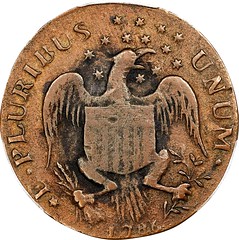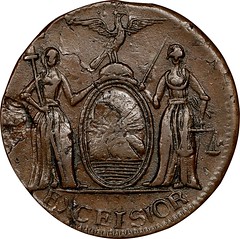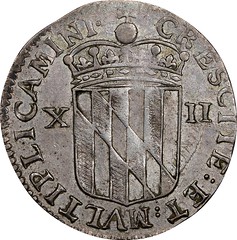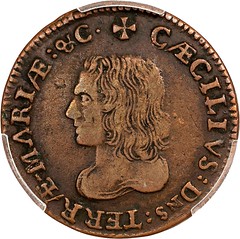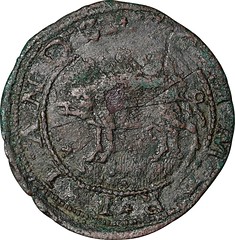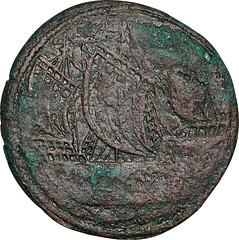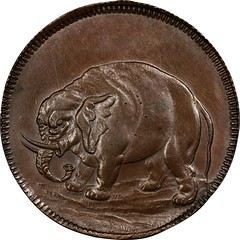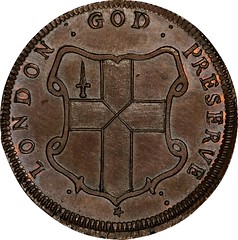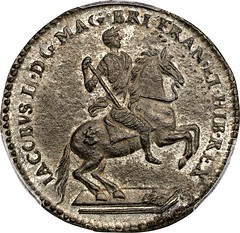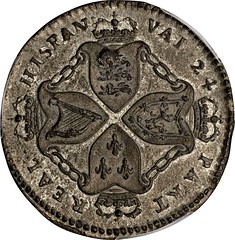
PREV ARTICLE
NEXT ARTICLE
FULL ISSUE
PREV FULL ISSUE
SYD MARTIN COLLECTION PART III HIGHLIGHTSHere are a number of highlights from the upcoming Stack's Bowers sale of the Syd Martin Collection, Part III. -Editor 1785 Immune Columbia / Nova Constellatio. W-1985, Breen-1120. Rarity-6+. Silver. Reeded Edge. 13 Stars. VF-20 (PCGS). Silver Immune Columbias are known with three different edge devices: vertical reeding, diagonal reeding, and no reeding at all. Of the just over a dozen examples known in total, five are vertically reeded (this one, the Norweb coin, the Earle-Jackman-Craige coin, the Newman coin, and the ANS specimen). If this suggests three separate emissions, it's unclear which came first or if any time separated them. The census of this issue, based upon Michael Hodder's work in the Norweb catalog, typically includes the Lauder specimen and a plain edge example in the "Ted Craige estate." The Lauder specimen was withdrawn before the sale in 1983 and disappeared; its authenticity has not been verified. We sold the Craige Estate coins in 2012 and 2013, and it did not include a silver Immune Columbia with plain edge. The Craige Estate collection did include the Earle-Jackman coin, graded PCGS EF Details, Damage, which brought $64,625. That piece had vertical edge reeding and was included on Hodder's Norweb census as coin #9. In recent years, we've sold the Roper plain edge piece (2017, graded EF Details, Graffiti by NGC, $51,700) and the superb Brand-Robison-Archangel coin (2018, graded PCGS AU-55, $102,000).
To read the complete lot description, see:
1785 Inimica Tyrannis / Confederatio. W-5630, Breen-1123. Rarity-7. Copper. INIMICA TYRANNIS AMERICA, Large Circle. EF-45 (PCGS). This is an extreme rarity. The Newman Unc. is far and away the finest known, graded MS-63 BN (NGC) and sold for $352,500 in its November 2014 auction offering. This is undoubtedly the second finest known. There were three additional cited by the Norweb cataloger: Norweb's, Roper's, and Garrett's; none of those are as nice as this one. A piece described as VF, found on a Metropolitan Coin Company fixed price list from 1961, was cited by the Newman cataloger. The piece in the 1910 Mougey sale, lot 1400, appears to be different from all of these and missed on the usual census listings. There are probably seven survivors, but it could be eight. Among these, the pecking order of first and second best is unquestioned. No design better summarizes the attitude of post-Revolutionary America than this one: America as a native warrior placing a Liberty cap on the Altar of Liberty while crushing the British crown underfoot within a peripheral legend INIMICA TYRANNIS AMERICANA or America, Enemy of Tyrants. While Taxay attributes authorship of this design concept to Robert Morris, it undoubtedly came instead from Morris' co-author of the tract Taxay cites: Propositions respecting the coinage of gold, silver, and copper. That piece was published in 1785, based on the May 13, 1785 report of the grand committee of the Continental Congress. The primary authors were Morris, who gave voice to his proposal that evolved into the Nova Constellatio patterns, and Thomas Jefferson, who preferred a competing decimal structure that ended up winning out in the long run. Pages 1 through 6 of the report, as published, were signed by Morris. Pages 9 through 12 were noted as including "NOTES on the Establishment of a MONEY MINT, and of a COINAGE for the UNITED STATES. By Mr. Jefferson."
To read the complete lot description, see:
1786 Immunis Columbia Copper. W-5675, Breen-1135. Rarity-8-. Large Eagle Reverse. EF-45 (PCGS). While the obverse die is different from the one employed in the Maris 3-C copper, this important rarity remains at least New Jersey adjacent. Its obverse device and date link it to the Maris 3 obverse, even if the precise piece of steel that made this wasn't the same as made that. Given its proximity to the New Jersey copper series, it isn't surprising that Dr. Edward Maris announced this variety's discovery after acquiring this precise specimen. As noted in the Ford II catalog: "Maris wrote that he had found the coin in a group of 16 coppers said to have been owned by a Vermont resident whose father had owned them for many years before that. Maris said that among the other coins in the group were three Vermont coppers all of the same variety, a 1787 Immunis Columbia, and a 1786 Immunis Columbia with New Jersey reverse (Maris 3-C)." His announcements of the discovery (July and September 1885 issues of Numisma and the October 1885 American Journal of Numismatics) were followed by a vociferous defense of this coin, a chorus joined by Crosby, Parmelee, Proskey, Frossard, and others.
To read the complete lot description, see:
1785 Confederatio / 1786 Heraldic Eagle Copper. W-5690, Breen-1131. Rarity-8. Large Circle. VF-30 (PCGS). 112.7 grains. 10 degree die rotation. A fascinating marriage of two mismatched dies, combining a Heraldic Eagle best known for an appearance on an extremely rare New Jersey copper with the CONFEDERATIO reverse of the Inimica Tyrannis Americana copper. Finely granular on both sides, a byproduct of ground exposure that gave this coin's surface a texture without chewing it up. The obverse is light brown with a halo of darker coloration around the eagle. The reverse is a more even sandy brown. The obverse die is aligned to 6 o'clock, where the 1786 date is complete but right at the precipice of the edge. The reverse is aligned upwards, and denticles are visible from 3 to 8 o'clock or so. The sharpness is excellent on both sides, arguably higher than the grade assigned. A few little marks are seen, including an old scrape on the eagle's neck, digs below C and D of CONFEDERATIO, and a couple short scratches within the upper left of the star cluster. Two dull dents are seen on the eagle's shield, the larger of which is close to center in the lower portion of the horizontal lines. The strike is even and solidly brings up even the fine central detail. Every variety that uses this 1786 Heraldic Eagle die is rare. The same could be said for the 1785 Confederatio die, of course, but the obverse is particularly interesting. It's married to a classic New Jersey reverse, Reverse C, to produce the Maris 5-C New Jersey variety. Only two of those are known, the Stickney-Garrett Uncirculated piece and an unconfirmed low-grade specimen. With neither of those pieces available to Maris (the Stickney coin was considered unique at the time), he illustrated the obverse with a coin owned by Bostonian Lorin Parmelee: this one. There are only two examples of this rarity known: the present one, with an august provenance, and an example that's been at the American Numismatic Society since 1942. They are similar overall. The ANS example may have a bit more detail, but its surfaces are a bit more granular, and it shows some rim damage.
To read the complete lot description, see:
1787 New York Excelsior Copper. W-5775, Breen-978. Rarity-7+. New York Arms / Heraldic Eagle Reverse. Eagle Facing Right, Arrows at Left. AU-53 (PCGS). 137.3 grains. 28.7 mm. 170 degree die rotation. A superb example of one of the rarest Excelsior coppers. Choice glossy medium brown with superb surfaces and eye appeal. A natural planchet lamination near 9 o'clock on the EXCELSIOR side is the principal identifying defect, related to a few less significant fissures on that side, including one that descends diagonally through the central arms. The Heraldic Eagle side is aligned to the left, common on this issue, and a tiny planchet clip is noted right of the date (similar to one seen on the Stickney coin). Both sides are exceptionally well detailed, and this distinctive Heraldic Eagle die stands out for both its small date and the arrows in the left claw. Some deeper toning and old harmless verdigris surround the stars and eagle device, and an arc die crack extends from the wing at left through PLUR. Aside from some scattered fissures on the EXCELSIOR side which give the planchet a somewhat crude appearance, this piece is problem free and free of post-striking issues.
To read the complete lot description, see:
1787 New York Excelsior Copper. W-5795, Breen-990. Rarity-6+. Standing Indian / New York Arms. VF-30 (PCGS). 180 degree die rotation. A superb example of this distinctive and provocative rarity, using a native American figure to project an image of American liberty with a legend that translates to "born free, I defend freedom." Smooth and glossy medium brown with exceptional eye appeal for the grade. The obverse is somewhat woodgrained, the reverse is a more even shade. The obverse is aligned to 8 o'clock by enough of a margin to show the outside border of the denticles at the upper right obverse, but by a small enough margin to allow the elegant peripheral legends to remain complete. The wear is even, the designs are nicely defined, and marks are few. Just two minor rim bruises at the upper right reverse require mention, though they are largely hidden by the encapsulation. Struck in the short interval when New York was strongly considering its own copper coinage, this was at least conceived as a pattern. If some small number was coined as extra spending money for the coiners who sought a contract, no one would be surprised; alas, the documents are silent and will likely remain such. Today, it is their design and their rarity that attract collectors primarily, not their interesting but obscure history. This one has been focal to several major cabinets and would be extremely challenging to upgrade.
To read the complete lot description, see:
Undated (1659) Maryland Lord Baltimore Shilling. W-1080, Breen-64, Hodder 1-A. AU-53 (PCGS). 69.8 grains. One of the very nicest survivors of this important issue, the first silver coin produced abroad exclusively for American circulation. Well centered and well struck, with attractive deep gray and light gray tones intermingled on lustrous surfaces. Both sides have a good deal of flash that suggests how remarkable these coins must have looked when first struck; alas, PCGS has certified only one Mint State coin, and these are essentially unknown finer than AU. Some trivial localized softness is present at the extreme periphery at 6 o'clock on the obverse and 12 o'clock on the reverse. Denticles frame the rest of the obverse border, while the reverse is slightly aligned to the right and shows denticles only at the left. Minor hairlines are visible under magnification but there are no heavy marks. We note a little scuff under Calvert's nose and a well hidden old scratch in the soft part of the crown a bit right of center. All of Lord Baltimore's coins are rare today, particularly in high grade, though a small hoard of sixpence has at least made them collectible. These coins saw actual circulation during their useful lives, as well as abundant abuse after: jewelry use and other sorts of damage are common. The last example we sold that was nearly this nice was a PCGS AU-50+ in our November 2012 Jack Royse sale that brought $49,937.50.
To read the complete lot description, see:
Undated (1659) Maryland Lord Baltimore Denarium. W-1000, Breen-76. Rarity-7-. VF-35 (PCGS). An extraordinary specimen of this preeminent American rarity, one of only two extant that doesn't bear witness to an earthen provenance. Very attractive medium brown with lighter brown devices, a bit more mahogany on the reverse than obverse. Perfectly centered on both sides and fully detailed, with just light, even wear apparent. Some old verdigris clings to the legends, very minor on the obverse, a bit more significant on the reverse in DENARIVM and the rightmost portion of the crown. The surfaces are hard and smooth, with a glass revealing only the most trivial granularity on the obverse. The color is nice, and the eye appeal is very positive on both sides. We recorded eight known examples (seven confirmed) when we last offered an example of this rarity in 2007. At that time, a specimen found with a metal detector near the mouth of the Rappahannock River, graded Very Good, brought $41,400. Two more have been discovered since: a very low grade grounder discovered in an English collection ca. 2018 (sold at Heritage as NGC VG Details in September 2019) and this example, which has never before been offered at auction.
To read the complete lot description, see:
Undated (ca. 1616) Sommer Islands Shilling. BMA Type II, W-11465. Large Sails. Fine-15 (PCGS). 88.6 grains. One of the most important and finest pedigreed Sommer Islands shillings around, highly regarded (and out of the ground) for well over a century. Its earliest known offering was in 1905 as part of the eight-day sale entitled "Catalogue of the Valuable Collection of Coins and Medals, the Property of the late John G. Murdoch, Esq., Member of the Numismatic Society of London, The Coins and Tokens of the British Colonies and Dependencies, America and the European Continent." This lot was purchased by Spink for £17; Spink purchased the NE shilling in the sale for £10, 5s. When we offered this piece in 2007, we described it as follows: "A coin of magnificent rarity, one of just a few Large Sails Hogge Money shillings in private hands. While any Sommer Islands shilling is a rarity, this coin is rarer still for several reasons: it is in private hands and not impounded in one of several institutions in Bermuda, the United States, or England; it is struck from the Large Sails reverse, from which far fewer pieces survive than the Small Sails reverse; and it has the added interest of a century-old provenance to one of the most famous and elaborate cabinets ever formed.
To read the complete lot description, see:
Undated (ca. 1694) London Elephant Token. Hodder 1-A, W-12000. Rarity-6+. GOD PRESERVE LONDON. Diagonals in Center of Shield. MS-64 BN (PCGS). 191.7 grains. A spectacular example of a very rare variety, showing diagonal lines (rather than simple right angles) at the center of the reverse shield. The obverse is boldly lustrous light brown, lightly reflective and magnificently well struck. Though ideally centered, the force of the strike has raised a wire rim atop that side. Only a few minuscule marks on the body of the elephant separate this from Gem status, though we note a nearly invisible short scratch between the border and the animal's eye. The reverse shows hints of mint color around some letters of the legend, exceptional luster and strike, and immaculate surfaces. A broad border is seen at the bottom of the reverse. The visual appeal is just superb. This is a rare variety in any grade. Archangel (who had most of the rare Elephants) lacked this. Norweb (who made a specialty of these varieties) had an EF. Dittmer's was a real cherry example, sold as MS-64 BN (NGC) at Heritage in May 2022 (at $50,400) and again in October 2022. The Craige coin was an EF-40 (PCGS). Aside from the Craige coin, the only other example our firm has handled in recent memory was an MS-62 BN (PCGS) sold in our August 2012 ANA sale for $52,875; it reappeared in the January 2022 Heritage sale. Partrick's was EF-45 (NGC) and Newman's was holed.
To read the complete lot description, see:
1694 New England Elephant Token. Hodder 2-G, W-12140, Breen-197, Betts-80. Rarity-8-. VG-8 (PCGS). 132.8 grains. Glossy and beautiful, rare and important, a famous example of this most charismatic colonial rarity. There are only three examples known: the beautiful Norweb coin, the very sharp but lightly burnished Mickley-Roper-Partrick coin, and this one, whose provenance is extensive and impressive over the last 150 years of ownership. When this piece was offered as part of the Garrett Collection in 1980, it was the first auction offering of a New England Elephant token since this exact coin sold in the 1890 Parmelee sale. The 1980s saw all three specimens auctioned (the Roper coin in 1983, the Norweb coin in 1987). Since then, there have been just two opportunities to buy a specimen: when this coin sold in 2015, and when the Roper coin appeared in the Partrick Collection sale of January 2021.
To read the complete lot description, see:
Undated (1688) American Plantations Token. Restrike. Newman 4-D, W-1150. Rarity-8. 11 Harpstrings. MS-63 (PCGS). The only reverse die to display 11 harpstrings, Newman's D reverse is found combined to obverse 4 and obverse 5. At the time that the Whitman Encyclopedia of Colonial and Early American Coins was published in 2009, this die marriage was listed as "existence not confirmed." We offered confirmation this variety existed in our (Stack's) January 2011 Americana sale, when we offered the MS-62 (PCGS) example that had earlier been in our June 1973 Briesland sale. It surprised most in the audience when it realized $25,300; it has been closely held ever since. At that time, we noted this reverse is "best attributed by the placement of the horse's front hooves relative to the X of REX and by the 11-string harp; since the strings are very hard to see and count in this metal, one may better think of this reverse die as the headless harp, as the usually seen female head has here devolved into a curved scroll!" It was the only documented specimen until Eric Newman's own specimen - this coin - appeared in the Heritage sale of May 2014.
To read the complete lot description, see:
Wayne Homren, Editor The Numismatic Bibliomania Society is a non-profit organization promoting numismatic literature. See our web site at coinbooks.org. To submit items for publication in The E-Sylum, write to the Editor at this address: whomren@gmail.com To subscribe go to: https://my.binhost.com/lists/listinfo/esylum All Rights Reserved. NBS Home Page Contact the NBS webmaster 
|
